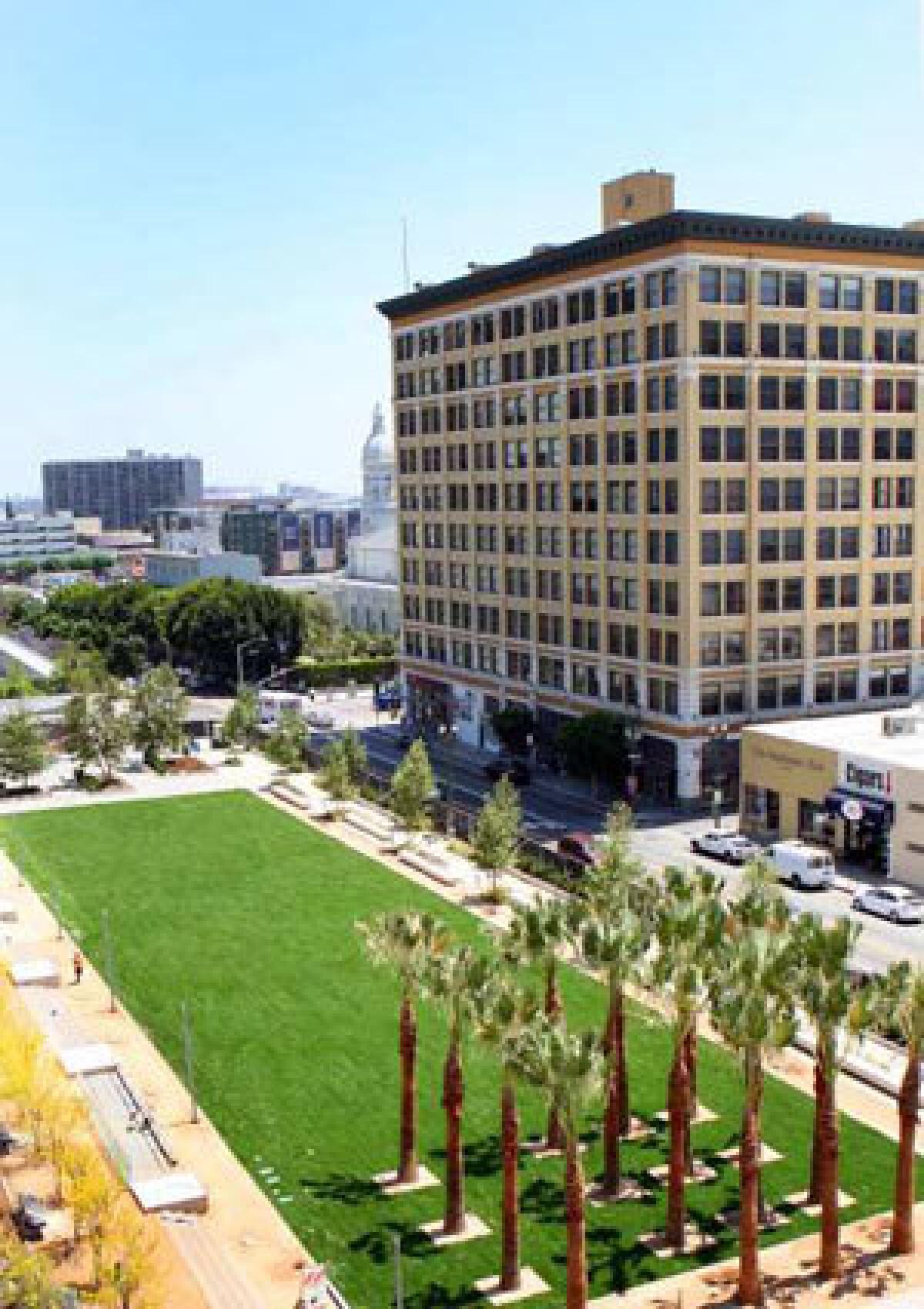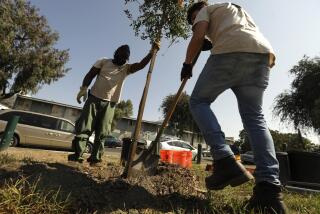LAPD green: landscaping at the new police headquarters

- Share via
As an expanded Los Angeles drought ordinance limiting lawn watering goes into effect June 1, the gardens across from City Hall at the new headquarters of the Police Department are nearing completion. What lies behind the draped chain link encircling the site may horrify conservationists, but it is bound to please local office workers and the loft dwellers who have been steadily gentrifying downtown.
There is lawn, nearly an acre of it.
If that sounds like a case of mixed messages from the city, it is, and it gets more confusing. Although irrigating turf is the single biggest waste of water in Southern California cities, the new LAPD headquarters is being heralded as a model of sustainability.
Earlier this week, three employees of Melendrez, the Los Angeles landscape and urban design firm responsible for the new garden, explained their intent. What was technically a commission to green up the space around an office building was almost from the start a tacit commission to build a park.
Parks, the Melendrez men said, are more than justifiable uses of lawn.
Scott Baker, a principal with the firm, and associates Matson Walter and Duane Border led a tour of six years of work, viewed from a distance so as not to violate city safety codes for construction sites.
Seen from The Times’ rooftop across the street, the LAPD garden shows how it earned its LEED Silver certification -- partly through the use of open space and water conservation. This is a lightly dry zone, done well.
According to the Melendrez team, the first question was: How to answer an existing row of London plane trees on the other side of Spring Street? That was straightforward. The designers repeated it on their side. There remained a decision on how to plant a 75-foot setback from the sidewalk without, as Baker put it, “having it feel suburban.”
The need for water efficiency and the desire to maintain a pedestrian scale helped here. They elected to use decomposed granite edging and a ribbon of palo verde trees, now in full yellow flower. Running beneath the palo verdes are smartly arranged beds of flax, rosemary and succulents in chic purplish hues. Then, next to the building, they sneaked in a band of tufted bright green fescue.
Yes, it’s lawn, they admitted, but at least they kept it long. That way it takes less water and less mowing.
On 1st Street, the entrance -- as viewed through a hole in the security sheeting -- is already spectacular. At least a quarter-acre of open space is a tiered affair. Beyond a fountain lined by rush reeds, an ascending row of five beds is shaded by Australian brush box trees.
Their botanical name is Tristania conferta, and Walter said he likes them for their stately open form. The city street-tree division recommends them for hardiness and drought tolerance.
The merits of the entrance register only after glancing across the street at the Caltrans building. If entrances could speak, Caltrans’ might say, “Keep out.” By contrast, the Police Department’s invites people to loiter.
Enticing the public was part of his brief, Baker said. Nothing was to be forbidding. Everything was to be welcoming. Open space in downtown is so tight, the idea was to create “social eddies” wherever and whenever possible.
The eddy turns into a lake at the other end of the building, by 2nd Street. Here the lion’s share of an acre of open space is given over to Marathon turf. There are no soccer fields or swing sets, but it’s park-like all the same. The grass creates that feeling, and the impression is then re-enforced by a walkway and another line of London planes shielding the lawn.
The inner nag of any conservationist would want to scold the city for unveiling lawn during a drought. But Melendrez will not apologize. The lawn is there in part to catch storm water runoff, said Walter, who added that outside of rainy season, it will be watered by a newfangled, efficient irrigation system.
It’s the type of sprinkler the city wants homeowners to investigate. Rotor heads have more accurate aim and trajectories that reduce water loss to wind and evaporation. Programming adjusts the water according to the weather and shuts down the system when it’s raining.
In case observers still aren’t sold, Walter is prone to inquiring: Did he mention the benefit of turf in mitigating the urban heat island effect?
Mainly, though, the lawn is there for the office workers and apartment dwellers who showed up at countless public meetings asking for it, Baker said. After the building opens this summer, the lawn will be there to be used, not for show, which even in a drought makes it a choice in the public interest, he said.


